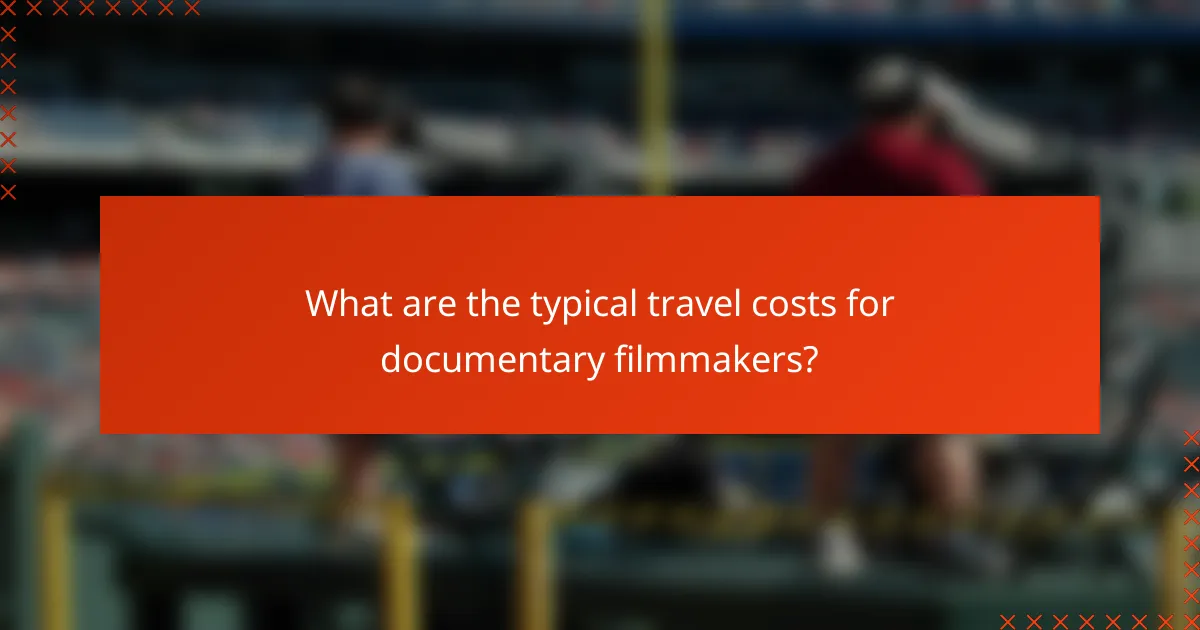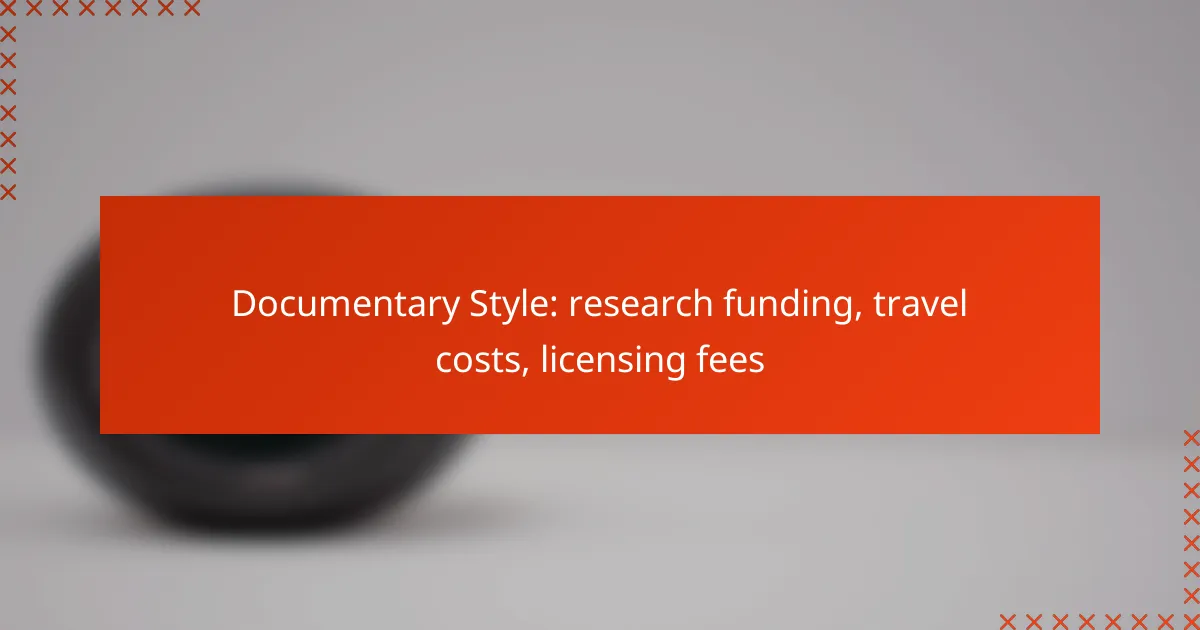Documentary filmmaking requires careful financial planning, particularly when it comes to securing research funding, managing travel costs, and budgeting for licensing fees. Exploring diverse funding sources such as grants and crowdfunding can provide the necessary resources to bring your vision to life. Additionally, understanding the travel expenses associated with your project and the costs of acquiring rights for footage and music is crucial for maintaining a balanced budget.

How to secure research funding for documentary projects?
Securing research funding for documentary projects involves exploring various sources such as grants, crowdfunding, and private sponsorships. Each option has unique requirements and benefits that can significantly impact your project’s budget and execution.
Grants from the National Endowment for the Arts
The National Endowment for the Arts (NEA) offers grants specifically for documentary projects that promote artistic excellence and cultural heritage. These grants typically range from a few thousand to several hundred thousand dollars, depending on the project’s scope and alignment with NEA priorities.
To apply, you must submit a detailed proposal outlining your project’s goals, budget, and artistic significance. Be mindful of deadlines and eligibility criteria, as these can vary annually. Successful applicants often demonstrate a clear connection to community engagement and artistic merit.
Crowdfunding through Kickstarter
Crowdfunding on platforms like Kickstarter allows filmmakers to raise funds directly from supporters. This method can yield anywhere from a few hundred to tens of thousands of dollars, depending on your network and promotional efforts.
To succeed, create a compelling campaign that includes a strong pitch video, detailed budget breakdown, and attractive rewards for backers. Engaging your audience through social media and regular updates can help maintain momentum throughout the campaign.
Private sponsorships from local businesses
Local businesses can be a valuable source of funding for documentary projects, often looking to support community initiatives. Sponsorships may include cash contributions or in-kind support, such as equipment or services.
To secure sponsorships, approach businesses that align with your documentary’s themes or target audience. Prepare a proposal that outlines the benefits of sponsorship, such as brand exposure and community goodwill. Building relationships and networking within your community can enhance your chances of obtaining these funds.

What are the typical travel costs for documentary filmmakers?
Travel costs for documentary filmmakers can vary significantly based on the destination, duration, and scale of the project. Key expenses include airfare, accommodation, and local transportation, which can add up quickly and impact the overall budget.
Airfare expenses for international shoots
Airfare is often one of the largest expenses for documentary filmmakers traveling internationally. Costs can range from a few hundred to several thousand dollars, depending on the destination, time of booking, and seasonality. Booking in advance and being flexible with travel dates can help reduce these costs.
Consider using flight comparison websites to find the best deals and keep an eye out for discounts or special offers. Additionally, filmmakers may benefit from travel rewards programs that can offset some of these expenses.
Accommodation costs in major cities
Accommodation costs in major cities can vary widely, influenced by location, type of lodging, and duration of stay. In cities like New York or London, hotel rates can range from low hundreds to over a thousand dollars per night. Budget options such as hostels or short-term rentals can provide more affordable alternatives.
Filmmakers should consider the proximity of accommodations to shooting locations to minimize transportation costs. Booking platforms often offer discounts for extended stays, which can further help manage expenses.
Local transportation expenses
Local transportation expenses can include taxis, public transit, or rental cars, and these costs can accumulate quickly during a shoot. In urban areas, public transportation is often the most cost-effective option, while rental cars may be necessary in more remote locations. Budgeting for these expenses is essential to avoid overspending.
Researching local transportation options ahead of time can help filmmakers choose the most economical and efficient means of getting around. Consider factors such as distance to shooting locations and the availability of services when planning your budget.

How to budget for licensing fees in documentaries?
Budgeting for licensing fees in documentaries involves understanding the various costs associated with acquiring rights to use footage, music, and interviews. Proper planning can help ensure that you allocate sufficient funds for these essential elements, which can significantly impact your overall budget.
Costs for archival footage licensing
Licensing archival footage can vary widely in cost, often ranging from hundreds to thousands of dollars per clip, depending on the source and usage rights. Factors influencing these costs include the length of the footage, the exclusivity of the rights, and the intended distribution channels.
When budgeting, consider reaching out to multiple archival sources to compare prices and negotiate terms. Some organizations may offer package deals or discounts for educational or non-profit projects, which can help reduce overall expenses.
Music licensing fees from ASCAP
Music licensing fees from ASCAP (American Society of Composers, Authors, and Publishers) can also vary based on the type of use and the popularity of the music. Fees may range from a few hundred to several thousand dollars, depending on factors like the duration of the music and the size of the audience.
To manage these costs, consider using lesser-known tracks or royalty-free music, which can be significantly cheaper. Always ensure that you obtain the correct licenses for your intended use to avoid potential legal issues.
Negotiating rights with interview subjects
Negotiating rights with interview subjects typically involves obtaining a release form that grants permission to use their likeness and voice in your documentary. This process can vary in complexity depending on the individual’s prominence and the intended use of their contributions.
When negotiating, be clear about how their interview will be used and any potential financial benefits they may receive. Offering a small fee or credit in the documentary can often facilitate smoother negotiations and ensure that all parties are satisfied with the arrangement.

What are the prerequisites for applying for documentary funding?
To apply for documentary funding, you typically need a well-defined project proposal, a detailed budget breakdown, and a clear timeline for project completion. These elements help funders assess the feasibility and impact of your documentary project.
Project proposal requirements
A solid project proposal is essential for securing funding. It should outline the documentary’s concept, objectives, target audience, and potential impact. Including a compelling narrative and visual elements can enhance your proposal’s appeal.
Additionally, you should detail the research methodology and any unique aspects of your documentary. Funders look for originality and relevance, so emphasize what sets your project apart from others.
Budget breakdown necessity
A comprehensive budget breakdown is crucial for demonstrating financial responsibility. This should include estimates for production costs, travel expenses, equipment rentals, and licensing fees. Providing a clear financial picture helps funders understand how their investment will be utilized.
Consider categorizing your budget into fixed and variable costs. Fixed costs might include salaries and equipment, while variable costs could encompass travel and location fees. This clarity can help in negotiations and adjustments later on.
Timeline for project completion
Establishing a realistic timeline for your documentary project is vital. This timeline should outline key milestones, such as pre-production, filming, and post-production phases. Funders appreciate a structured approach that shows you can meet deadlines.
Include buffer time for unforeseen delays, such as travel disruptions or licensing negotiations. A well-planned timeline not only aids in project management but also reassures funders of your commitment to timely delivery.

How to choose the right funding sources for documentaries?
Choosing the right funding sources for documentaries involves identifying grants and organizations that align with your project’s goals and needs. Consider factors such as eligibility criteria, funding amounts, and the specific interests of the funding bodies.
Evaluating grant eligibility criteria
Start by reviewing the eligibility criteria for various grants. Many funding organizations have specific requirements regarding the type of projects they support, such as documentary length, subject matter, or target audience. Ensure your project fits these criteria to avoid wasting time on unsuitable applications.
Additionally, check for geographic restrictions, as some grants may only fund projects based in certain countries or regions. For instance, a grant may focus on European documentaries, requiring applicants to be based in the EU or address topics relevant to European audiences.
Assessing alignment with funding organization goals
Once you have a list of potential funding sources, assess how well your documentary aligns with their goals. Review their mission statements and past funded projects to understand their priorities. This alignment increases your chances of securing funding.
Consider creating a simple matrix to compare your project’s themes and objectives with those of the funding organizations. Highlight commonalities and tailor your proposal to emphasize these connections, demonstrating how your documentary supports their mission.

What are the emerging trends in documentary funding?
Emerging trends in documentary funding reflect a shift towards more diverse and accessible sources of financial support. Filmmakers are increasingly leveraging digital platforms, crowdfunding, and partnerships to secure the necessary resources for their projects.
Increased reliance on digital platforms
Documentary filmmakers are turning to digital platforms for funding, distribution, and audience engagement. Services like Kickstarter and Indiegogo allow creators to raise funds directly from viewers, often resulting in a more engaged audience who feel invested in the project.
Additionally, streaming services such as Netflix and Amazon Prime Video are not only providing funding but also serving as distribution channels. This trend enables filmmakers to reach global audiences while securing financial backing, though it often requires navigating complex licensing agreements.
When using digital platforms, it’s crucial to have a clear marketing strategy to attract potential backers. Engaging social media campaigns and compelling project pitches can significantly enhance funding success. Filmmakers should also be mindful of platform fees and the terms of service that may affect their project’s revenue.



